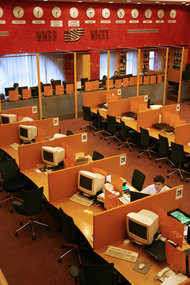 Alexey Sazonov/Agence France-Presse — Getty ImagesTraders at the Micex in 2008.
Alexey Sazonov/Agence France-Presse — Getty ImagesTraders at the Micex in 2008.
MOSCOW — Russia’s main stock exchange has garnered enough investor interest for an initial public offering, another milestone in the country’s capitalist evolution.
The Moscow Exchange, better known by its original name, Micex, for the Moscow Interbank Currency Exchange, is scheduled to begin trading Friday in Moscow on its own trading platform.
The stock will price near the bottom of the expected range, valuing the company at slightly more than $4 billion, a financial industry official briefed on the plan said Thursday evening.
The listing drew interest from specialized investors in financial services companies and institutional investors in the United States and Europe, the official said. Micex has also benefited from the publicity of mergers and acquisitions in the stock exchange business worldwide, including the announced sale of the New York Stock Exchange.
The seesaw fortunes of the Russian companies that list on Micex have made it one of the world’s most volatile markets. From its inception in 1992 until the start of the 2008 recession, the Russian stock market had been in either the top five performing markets in the world or the bottom five in every year except one.
The company managing the exchange, though, has made an argument that it is a far safer bet than the companies it lists because it earns fees on both long and short trades and from foreign currency deals, its original niche.
The Russian central bank founded Micex as a market for trading rubles into foreign currency legally, something that had been tightly regulated in the past. That was the best thing that ever happened to early post-Soviet financiers, who knew which way that bet would go and made easy fortunes on Micex.
The exchange evolved to trade stocks when they appeared in Russia in the early 1990s and presided over the panic selling of state bonds in the 1998 default. By 2011, it was the dominant exchange after it merged with a rival, the Russian Trading System. The main product of the Russian Trading System was a dollar-denominated derivative of an index fund for the Russian market, used primarily to short the entire country’s economy, a position sometimes used as a hedge by nervous companies making other investments. Last year, this product accounted for 34 percent of all derivatives trades on Micex.
Other revenue streams are interest income from obligatory deposits that brokerage firms place with the exchange to trade, fees charged to issuing companies and data sales.
The central bank will remain the largest shareholder after the issue of 10 to 15 percent of the shares. The organizing banks are expected to announce the size of the float on Friday.
Mattias Westman, founder of Prosperity Capital Management, the largest foreign portfolio investor in Russia, which manages $4.5 billion in stocks and other assets, many of which are traded on Micex, said owning shares in the stock exchange was also a way to bet on the strengthening domestic financial system.
Micex’s offering, he said, “is a symptom of the whole market maturing,” 20 years after the end of the Soviet Union.
Bruce Bower, portfolio manager at Verno Capital, a Russia-focused fund, said the exchange’s mix of offerings for investors wanting either long or short positions, its interest earnings and fees for currency exchange made it a relatively safe stock as “the financial utility for Russia.”
Article source: http://www.nytimes.com/2013/02/15/business/global/russias-largest-stock-exchange-begins-trading.html?partner=rss&emc=rss
Speak Your Mind
You must be logged in to post a comment.